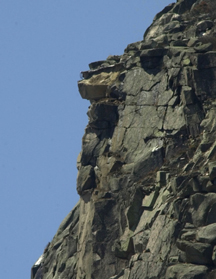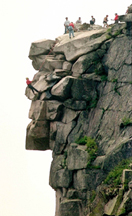Geotimes

Web
Extra Monday,
May 5
Old Man of the Mountain is
down
 New Hampshire's
venerable profile of the Old Man of the Mountain fell last weekend as a result
of erosion beating almost a century of human efforts to secure the granite overhang
to Cannon Mountain. Beginning as early as 1916, the state has used steel buckles
to prevent the rock precipice from falling off the cliff face. In 1937, the
state began using epoxy to help seal cracks as they developed. But the freezing
and thawing cycle, which originally helped to form the profile that became the
state symbol, ultimately also caused its demise.
New Hampshire's
venerable profile of the Old Man of the Mountain fell last weekend as a result
of erosion beating almost a century of human efforts to secure the granite overhang
to Cannon Mountain. Beginning as early as 1916, the state has used steel buckles
to prevent the rock precipice from falling off the cliff face. In 1937, the
state began using epoxy to help seal cracks as they developed. But the freezing
and thawing cycle, which originally helped to form the profile that became the
state symbol, ultimately also caused its demise.
 At
left, the current view of the scarp face and, at right, the Old Man of the Mountain
with climbers working in the 1990s to help secure the granite profile (AP Photos).
At
left, the current view of the scarp face and, at right, the Old Man of the Mountain
with climbers working in the 1990s to help secure the granite profile (AP Photos).
State geologist David Wunsch of New Hampshire explained that most granite features
are smoothed down over time and that the Old Man had become the exception rather
than rule. "It was only matter time before physical processes would loosen
him up to become unstable," he says. Rock climbers that spent Friday night
at the base of a trailhead to Cannon Cliffs later told local reporters that
they had heard a rumble between midnight and 2 a.m.
Upon learning of the fall from park officials Saturday morning, Wunsch and
Brian Fowler, president of the engineering and geology consulting firm North
American Reserve, flew by helicopter to investigate the scarp site. In 1980,
Fowler had reported that the granite feature had an equal amount of driving
forces acting upon it to bring it down as it had resistant forces helping to
keep it up. "We concluded after a year's worth of measuring and analyzing
the granite, that the stability of the profile was very delicate and even fragile,"
Fowler says. His team's work at the time helped prevent destructive blasting
that would further damage the structure during highway construction through
the town of Franconia.
"Fortunately this didn't happen because of blasting, but because of the
natural processes of weathering of granite," Fowler says. The freezing
and thaw cycles on mountainside he explains, "changed the strength and
characteristic of the rock underneath the profile which compromised its structural
support." He called the collapse a "toppling failure and not a sliding
failure." Based on the evidence of fine granite debris, or grus, still
remaining on the scarp face, the Old Man of the Mountain toppled off of the
cliff with its forehead falling first and the rest rolling with it rather than
the chin giving way and the whole head sliding down the cliff.
Visitors to the geologic site are leaving flowers in remembrance to the Old
Man of the Mountain.
Christina Reed
Links:
New
Hampshire Division of Parks and Recreation
The Union Leader
 New Hampshire's
venerable profile of the Old Man of the Mountain fell last weekend as a result
of erosion beating almost a century of human efforts to secure the granite overhang
to Cannon Mountain. Beginning as early as 1916, the state has used steel buckles
to prevent the rock precipice from falling off the cliff face. In 1937, the
state began using epoxy to help seal cracks as they developed. But the freezing
and thawing cycle, which originally helped to form the profile that became the
state symbol, ultimately also caused its demise.
New Hampshire's
venerable profile of the Old Man of the Mountain fell last weekend as a result
of erosion beating almost a century of human efforts to secure the granite overhang
to Cannon Mountain. Beginning as early as 1916, the state has used steel buckles
to prevent the rock precipice from falling off the cliff face. In 1937, the
state began using epoxy to help seal cracks as they developed. But the freezing
and thawing cycle, which originally helped to form the profile that became the
state symbol, ultimately also caused its demise. 
 At
left, the current view of the scarp face and, at right, the Old Man of the Mountain
with climbers working in the 1990s to help secure the granite profile (AP Photos).
At
left, the current view of the scarp face and, at right, the Old Man of the Mountain
with climbers working in the 1990s to help secure the granite profile (AP Photos).